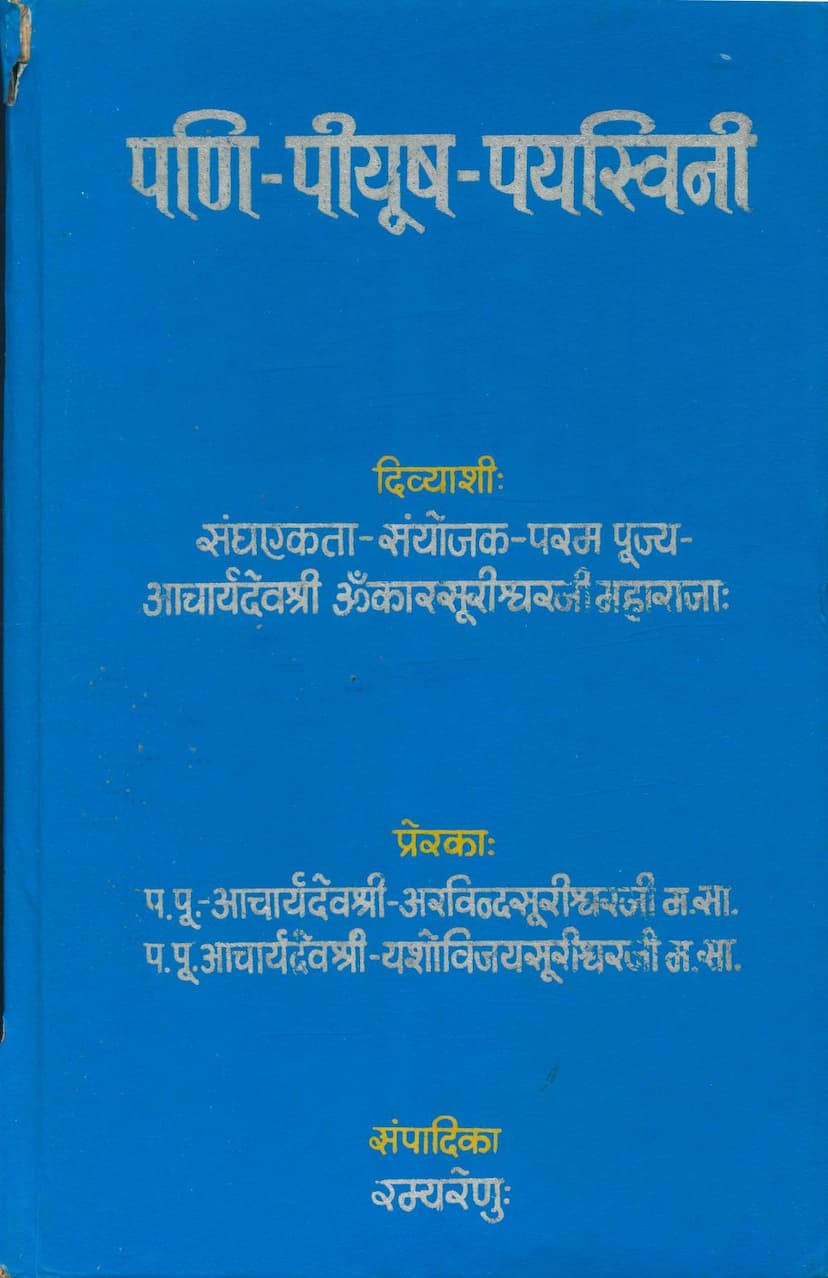Pani Piyush Payasvini
Added to library: September 2, 2025

Summary
The Jain text "Pani Piyush Payasvini" (પાણી- પીયુષ- પયસ્વિની), authored by Ramyarenu and published by Omkar Sahitya Nidhi, is a collection of devotional hymns and praises dedicated to Jain Tirthankaras and other revered figures. The title itself, "Pani Piyush Payasvini," translates to "River of Nectarous Milk," suggesting the sublime and life-giving nature of the devotional verses contained within.
Key aspects and contents of the book include:
- Title and Meaning: The title signifies the sweet, life-sustaining, and pure essence of the devotion presented, likening it to a flowing river of nectarous milk.
- Authorship and Publication: Authored by Ramyarenu and published by Omkar Sahitya Nidhi, the book is a product of devotional dedication and scholarship within the Jain tradition.
- Content: The book primarily consists of:
- "Shobhan Stuti Chaturvimsatika" (शोभनस्तुति-चतुर्विंशतिका): This section comprises twenty-four verses of praise dedicated to Shobhan Muni, who was the younger brother of the renowned Jain poet Dhanpalji. Shobhan Muni, also known as "Svadhyay Muni" (स्वाध्यायमुनि), was deeply engrossed in spiritual study, and these verses likely reflect his profound devotion and spiritual insights. The verses are described as being in "Ramya Padadhikopeta" (रम्यपदधिकोपेता) style, indicating a poetic and aesthetically pleasing composition.
- "Prakirnak Stutayo" (प्रकीर्णकस्तुतयश्च): This section includes miscellaneous hymns of praise, likely covering various Tirthankaras and other significant Jain figures or concepts. The catalog link provided mentions "Ramya Padadhikopeta Prakirnak Stutayashcha" (रम्यपदधिकोपेताः प्रकीर्णकस्तुतयश्च), indicating that these miscellaneous hymns are also composed in the "Ramya Padadhikopeta" style.
- Commentary and Interpretation: The book features a commentary called "Ramyapadabhijika" (रम्यपदभञ्जिका) or "Ramyapadabhnjika" (रम्यपदभञ्जिका) on the original verses, written by Sadhviji Hemgunashriji and Sadhviji Divygunashriji under the guidance of Acharya Shri Arvind Surishwarji Maharaj and Acharya Shri Yashovijaysurishwarji Maharaj. This commentary is crucial for understanding the profound meaning and nuances of the original verses. The text explicitly mentions that creating a commentary on such learned works is not a simple task, and the commentary aims to provide a clear understanding of the original author's intent.
- Spiritual and Scholarly Guidance: The book is blessed with the guidance and inspiration of highly revered Jain Acharyas:
- Param Pujya Acharya Dev Shri Oankar Surishwarji Maharaj: He is the convener of "Sangh Ekta" (संघ एकता - Unity of the Community), suggesting his role in promoting unity within the Jain community.
- Param Pujya Acharya Dev Shri Arvind Surishwarji Maharaj: He is mentioned as an inspirer.
- Param Pujya Acharya Dev Shri Yashovijaysurishwarji Maharaj: He is also mentioned as an inspirer.
- Acharya Shri Vijay Karmsurishwarji Maharaj: Mentioned as the sculptor of the Sangha's unity.
- Acharya Shri Vijay Arvindsurishwarji Maharaj: His blessing for the work is acknowledged.
- Acharya Shri Vijay Yashvijaysurishwarji Maharaj: His blessings are also noted.
- Patronage and Support: The book acknowledges the financial support from Shri Pankaj Society Jain Sangh, Paldi, Ahmedabad, and also mentions the printer, Kantilal D. Shah of Bharat Printing Press, for their contribution to the aesthetic presentation of the book.
- Themes: The text delves into themes of devotion, praise, spiritual study (Svadhyaya), understanding the essence of Jain scriptures, and the importance of commentaries for deeper spiritual insight. The introductory remarks emphasize the value of Svadhyaya as a supreme penance and the journey from words to the unspoken, reaching realms of experience beyond logic.
- Structure: The book is divided into two main sections:
- The first section focuses on the "Shobhan Stuti Chaturvimsatika," providing the original hymns with their context, meaning, grammatical explanations (Samas), and references to scriptural sources.
- The second section includes popular miscellaneous hymns such as those for Gyan Panchami, Maun Ekadashi, Deepavali, Paryushan Parva, Shri Siddhachakra, and Tirth Vandana, also accompanied by their explanations.
- Linguistic and Grammatical Depth: The commentary includes detailed analysis of Sanskrit grammar, including Samas (compound words) and their constituent Sutras, drawing references from various influential Jain grammatical and lexical works like Amar Kosh, Abhidhan Chintamani Namamala, and Shri Hemchandracharya's Siddhahem Shabdhanushasan. It also meticulously breaks down the etymology and meaning of words, demonstrating a deep commitment to scholarly rigor.
In essence, "Pani Piyush Payasvini" is a significant Jain literary work that combines devotional sentiment with rigorous scholarly analysis, aiming to make the profound teachings and praises of Jainism accessible and understandable to a wider audience, particularly through the detailed commentary provided. It serves as a guide for spiritual practice and intellectual pursuit within the Jain philosophical framework.